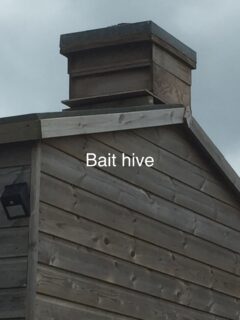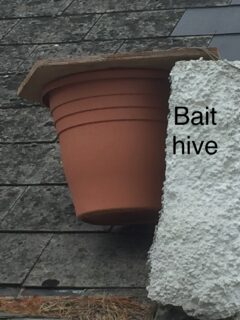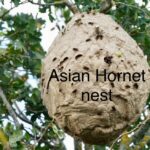
For a few days in April I thought the beekeeping season had started! The weather was warm, the bitter, north-easterly wind had finally dropped and the bees were going crazy for nectar and pollen. Some of my hives were so full of bees they were virtually pushing the crown-board off so desperate were they for more space. The euphoria was short-lived, though, as the temperatures dropped again and we went back to the colder conditions which we have been experiencing of late. Whilst you’re in the sun it’s fine but if the sun goes behind a cloud then the temperature appears to drop like a stone.
However, during brief respites, I was able to remove the crown-boards from my fuller hives, place a queen excluder on top of the brood box and add the first empty super of the season. The bees took no notice whatsoever, as the foraging bees were out in the fields leaving the hive with a much smaller work-force of mainly young bees. The hives which I worked on had bees occupying nearly all of the frames, so they were ready for the extra space.
The other hives that I was able to check were not as heavily populated with bees and are not quite ready for a super. If a super is added too early it can have detrimental consequences for the bees as the greatly increased volume allows heat loss from the brood nest. This gives the bees a lot more work to do to maintain the ideal conditions of temperature and humidity, so is best left until the bees are on about 7 or 8 combs in the brood box. Another two weeks and these less-advanced hives will be ready for their supers and hopefully the weather will improve to the point that I can do a disease check but to do that at this time could result in chilling of the brood and certainly loss of heat from the brood nest.
I have mentioned before the bees’ need for water. Well, the number of bees accessing my bird bath has increased somewhat over the past month, which is a good indication that things are looking promising. The bees are using the water to dilute their stores in order to be able to feed their young and also to regulate the temperature and humidity in the hive. Judging by the rate at which the bees are emptying the bird bath (or it might be the wind and sun drying it out!), there’s an awful lot of brood needing feeding and some large brood nests needing controlled conditions!
It’s almost swarming season again, though the recognised indicator of intended swarming, viz. the presence of drones, has not been evident yet. I actually haven’t seen a single drone so far this season! However, in anticipation of early swarms I have already installed my bait hives round and about. I have three in my home apiary, two others in my  garden, two at one of my out-apiaries and another will be going onto the shed of my beekeeper friend which picked up four swarms of black bees last year. I have also set up two empty hives in my apiary with some old brood comb, though I am not expecting anything from this. Bees, when they are swarming, tend to fly at a height of about 12’ to 15’, so most of my bait hives are set up in trees or on the rooves of out-buildings, where they are more likely to be found by scout bees looking for a new home.
garden, two at one of my out-apiaries and another will be going onto the shed of my beekeeper friend which picked up four swarms of black bees last year. I have also set up two empty hives in my apiary with some old brood comb, though I am not expecting anything from this. Bees, when they are swarming, tend to fly at a height of about 12’ to 15’, so most of my bait hives are set up in trees or on the rooves of out-buildings, where they are more likely to be found by scout bees looking for a new home.
But, as it is not unknown for bee swarms to occupy empty hives at ground level, I thought I might as well prime these empty hives as hives – just in case! When bees are looking for a new home they are wanting about 45 litres of space to establish their new brood nest and colony. If any potential residence also has a smell of bees or beeswax, indicating that bees have previously occupied this enclosure, then it is more attractive to a swarm. This is achieved by placing an old comb of beeswax in an appropriate chamber, eg a brood box or, as I have got, a large flower tub.

Once the swarm has arrived in the bait hive, it is transferred to a permanent brood box and the old comb is left in the bait hive, so there is no danger of the old comb being a disease vector. I also smear a small amount (no more than a drop or two) of lemongrass essential oil at the entrance and inside the hive as a further attractant. It is believed that this smell is similar to the pheromone released from the Nasenov gland of the honey bee and is a “homing” scent which is attractive to bees.
I have come across a few queen wasps already this year, hibernating in our lined bedroom curtains and emerging on warm days thinking that Spring is here (it’s really not, guys!).
 They won’t be building nests this season! However, there will be sufficient queens around in nature which will escape my eagle eye and establish nests so they can do their predatory job on the lesser garden pests before they turn their attentions to my hives, at which point they had better look out!
They won’t be building nests this season! However, there will be sufficient queens around in nature which will escape my eagle eye and establish nests so they can do their predatory job on the lesser garden pests before they turn their attentions to my hives, at which point they had better look out!
As well as queen wasps coming out of hibernation, the Asian (or yellow-legged) Hornet queens are also starting to emerge and if they get the timing right (ie they emerge when the weather has finally settled to a warmth they can survive in), they too will be looking to build nests. One has already been sighted in Felixstowe on 29 April, so please keep a lookout for them and also for their nests. The nests look similar to those of the European hornet but the primary nests will be about four or five feet off the ground, most likely in a bushy shrub.

Secondary nests won’t be established until later in the season – I’ll tell you when that time comes. It’s easy to differentiate the two hornet types from their abdominal bandings:

Please don’t just ignore suspected Asian Hornet sightings or nests and hope they’ll die or go away – they won’t – and once established in the UK the beekeeping community will have a huge problem on their hands and your precious honey might become a rarity.
For Asian Hornet sightings (or suspected sightings) contact alertnonnative@ceh.ac.uk
or give me a call and I’ll alert our Asian Hornet Action Team (AHAT) on the Roseland.
Colin Rees 01872 501313 07939 971104 colinbeeman@aol.com

